Looking to infuse your home with the warmth, romance, and artisan texture of the Iberian Peninsula? Spanish interior design celebrates layers of stucco, hand-painted tiles, forged iron, and sun-baked hues that feel timeless yet relaxed, making it one of 2025’s most requested looks among designers. From rustic hacienda farmhouses to sleek modern hybrids, the following twenty Spanish interior design ideas show exactly how to translate classic elements into rooms that suit contemporary lifestyles without losing their soulful Mediterranean roots.
1. Spanish Interior Design Stucco Walls with Rough Texture

A softly mottled stucco wall is the quickest way to evoke an Andalusian courtyard inside. Begin by applying a lime-based plaster in thin, uneven coats, then burnish only enough to catch the light so every imperfection reads as patina, not damage. Designers love the technique because the sandy finish bounces warmth around a space and pairs effortlessly with terracotta floors and dark woods. The Spruce notes that white or pale-neutral stucco also amplifies natural cooling in hot climates, making it both aesthetic and practical. Accent the surface with a shallow niche or arched inset to spotlight ceramics or devotional art for an authentic touch.
2. Spanish Interior Design Terracotta Tile Floors
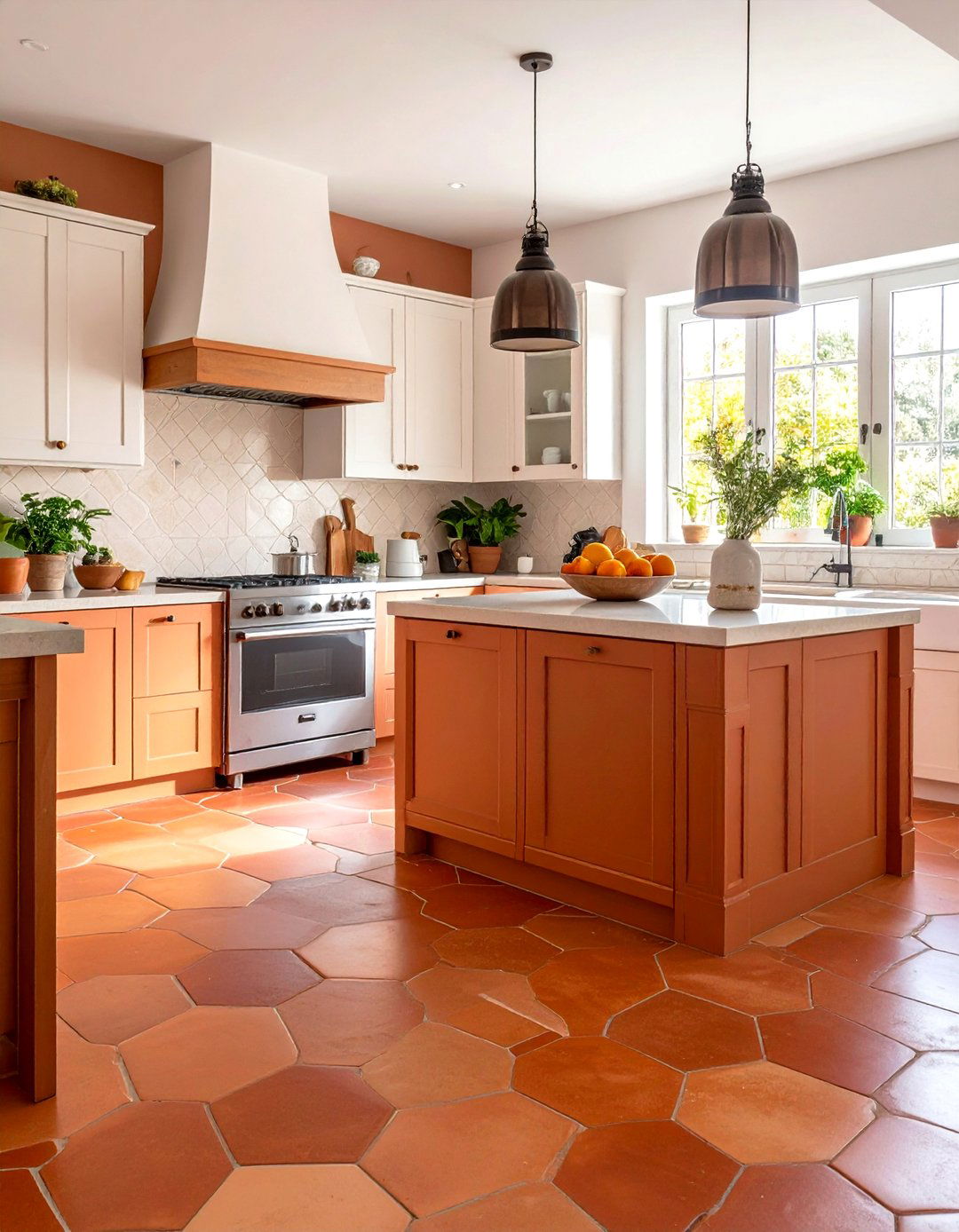
Few materials express sun-kissed Spain like fired-clay terracotta. Opt for handmade hex, Arabesque, or saltillo tiles; their irregular edges and color variation keep rooms feeling alive rather than flat. Seal them with a matte penetrating wax to preserve porosity while repelling spills. Woodgrain adds that the burnt-orange tones become a grounding neutral that flatters everything from creamy stucco to bright cobalt benches. For smaller projects, lay a terracotta border around sisal rug insets instead of resurfacing an entire floor; the contrast highlights the cool weave of natural fibers and instantly telegraphs Mediterranean leisure. Choose herringbone patterns to energize narrow halls.
3. Spanish Interior Design Exposed Rustic Wood Beams
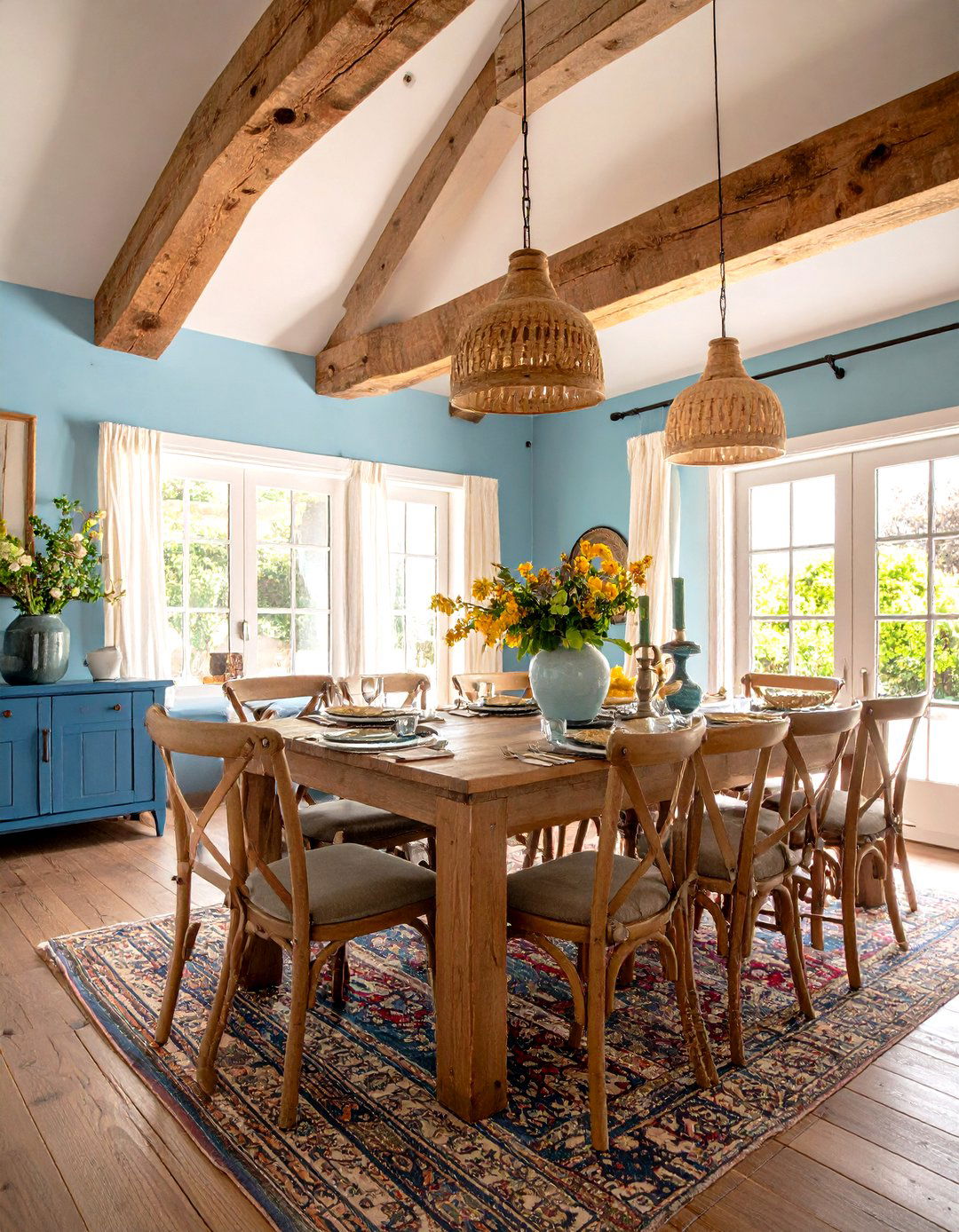
Massive, time-worn ceiling beams anchor Spanish rooms and visually lower tall volumes for coziness. Salvaged pine or chestnut with visible saw marks works best; leave wormholes and cracks untouched, then finish with a light coat of linseed oil so grain stays tactile. According to Architectural Digest, beams painted in a soft espresso stain frame chandeliers beautifully while echoing dark window casings. If structural beams are impossible, faux hollow boxes screwed to joists deliver identical character. Pair the timber with white plaster ceilings to heighten contrast, or run beams outdoors across a loggia for seamless indoor-outdoor flow that unites patios with internal lounges.
4. Spanish Interior Design Decorative Wrought Iron Accents

From curling stair balustrades to hammered strap-hinges on doors, wrought iron delivers essential Spanish drama. Houzz ranks decorative iron as the number-one revival feature, noting its ability to add weight without visual bulk when used in light fixtures or mirror frames. Woodgrain further highlights mosaic backsplashes framed in iron for old-world glamour. For an affordable upgrade, swap basic cabinet pulls for blackened-iron latches and top with burnt-yellow Talavera knobs for a refined folk twist. Outdoors, suspend a six-arm forged lantern over the entry to cast lace-like shadows that hint at romance even before guests step inside on a warm Spanish evening.
5. Spanish Interior Design Moorish Tile Focal Wall
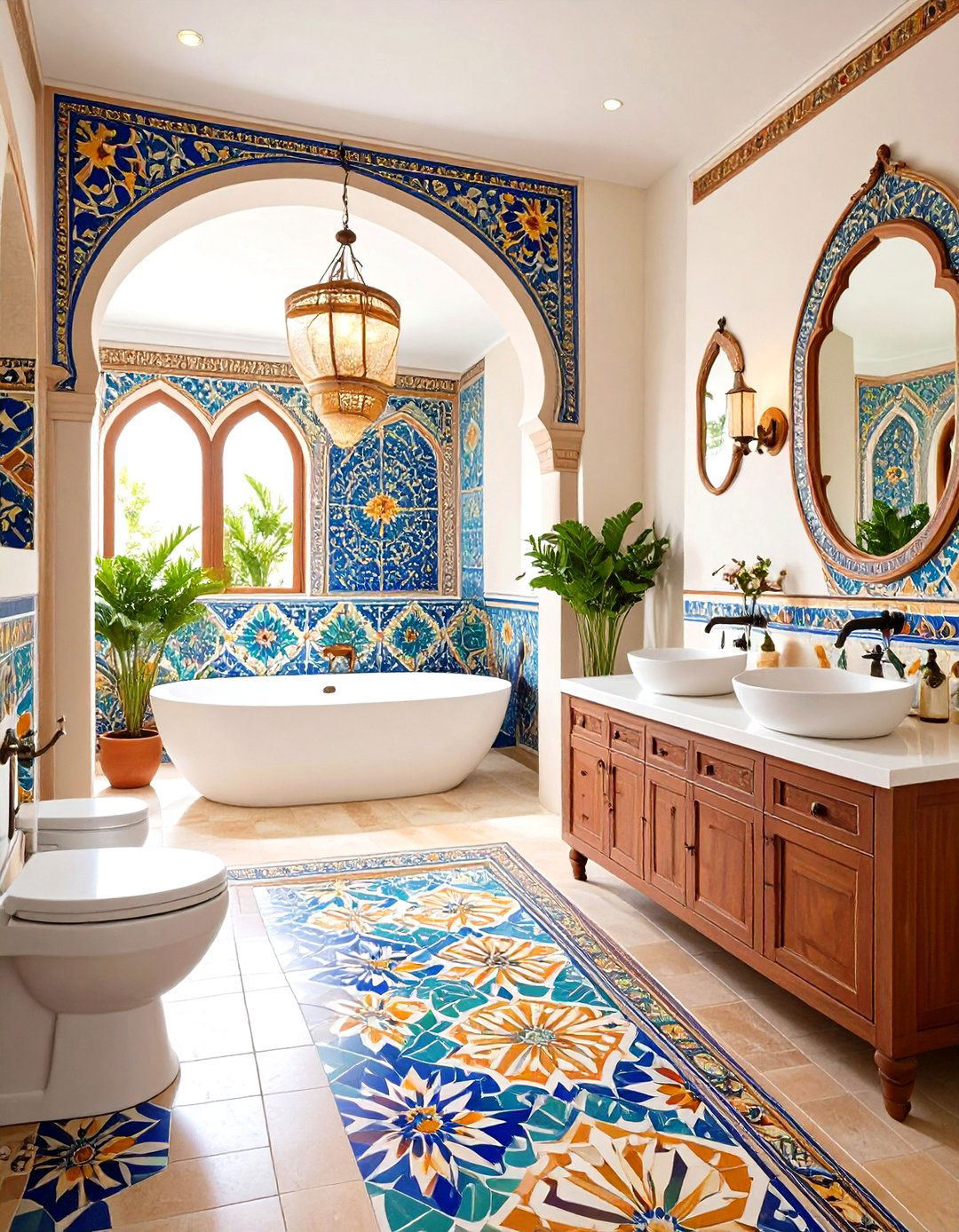
Introduce a splash of Al-Andalus by covering one statement wall in geometric Moorish tile. Choose star-and-cross or zellige-inspired patterns rendered in cobalt, ochre, and emerald for unmistakable heritage. Designers often reserve the treatment for fireplace surrounds or powder-room backsplashes where intricate motifs read as art. Architectural Digest reports that pairing ornate tile with understated stucco keeps rooms balanced instead of busy. Border the field with slim terracotta liners to transition gracefully into adjacent surfaces, then echo a single tile color in cushions or pottery to pull the palette through the space. Subtle uplighting will make the glaze shimmer brilliantly after.
6. Spanish Interior Design Colorful Talavera Pottery Displays
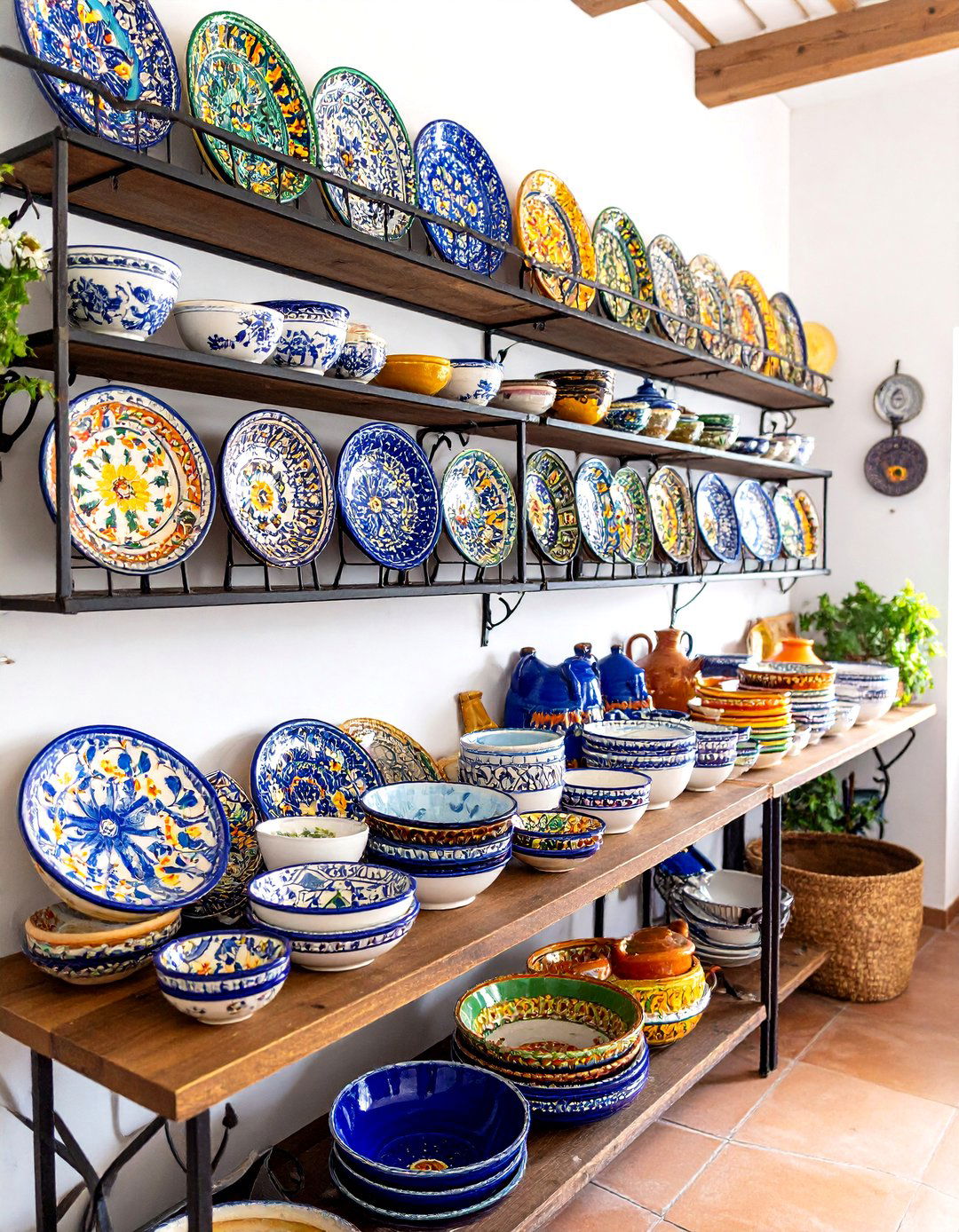
Line open shelving with hand-painted Talavera bowls, urns, and platters to inject joyous pattern without committing to permanent finishes. Direct From Mexico explains that the 16th-century craft blends Spanish, Moorish, and Mexican influences, giving pieces their signature indigo, sienna, and sun-gold flourishes. Position the ceramics against matte stucco so the gloss pops, and vary heights with small turned-wood pedestals for a collected-over-time feel. Elle Decor showcases similar vignettes where oversized Talavera jars flank fireplaces like sculptural guardians. For safety in kitchens, install a narrow iron rail across shelves to prevent cherished dishes from sliding during daily bustle or lively celebrations.
7. Spanish Interior Design Arched Doorways & Niches
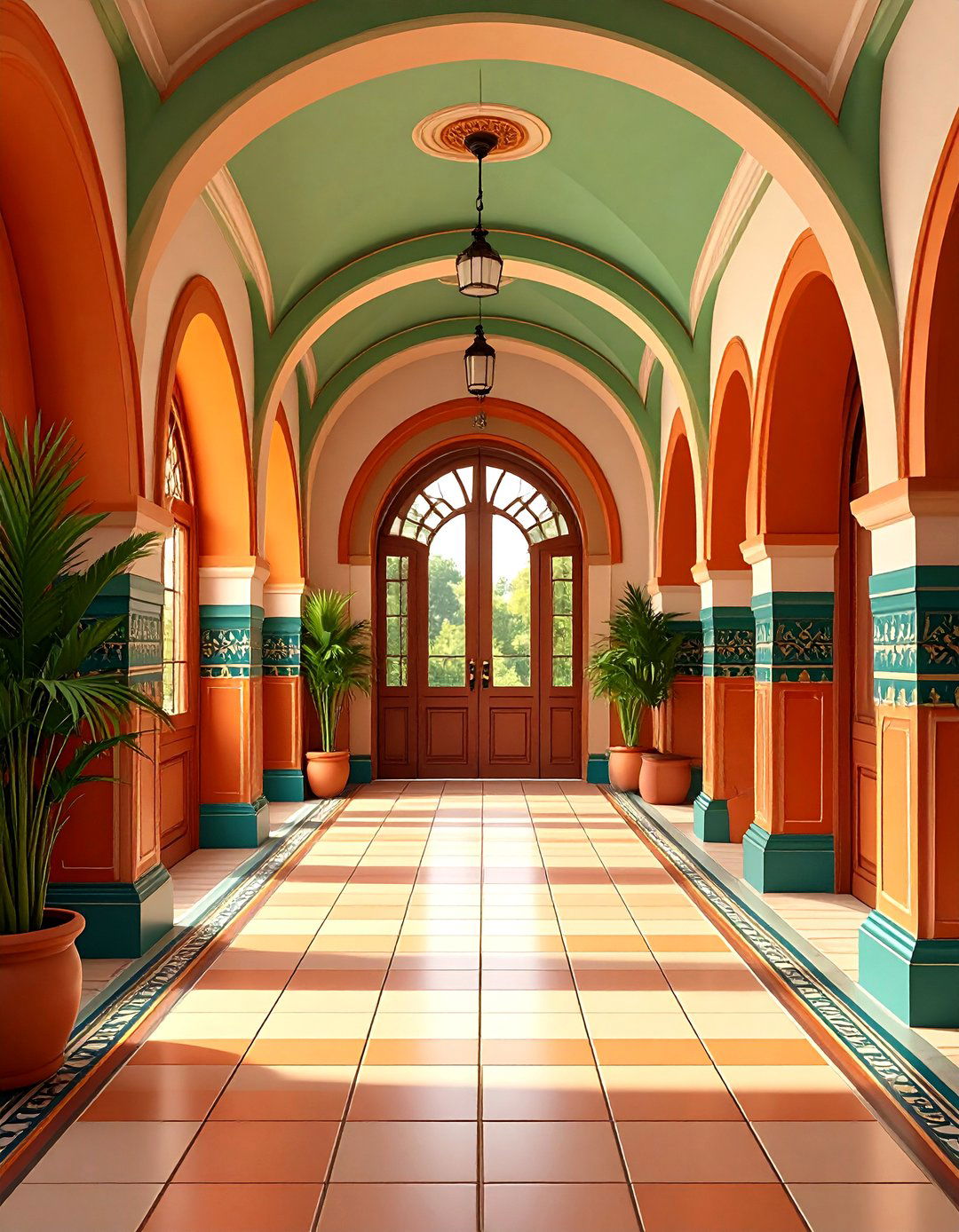
Arches instantly telegraph Spanish lineage, softening transitions and framing vistas like living picture windows. Better Homes & Gardens notes that low-pitch clay roofs traditionally paired with arched entryways to mitigate sun glare, a proportion that still feels timeless indoors. Carve shallow wall niches with elliptical crowns to display santos figures, or convert a square door opening to an arch using a bent-ply template and new plaster. Veranda’s recent Hollywood Revival tour shows how even narrow hallway arches build anticipation as rooms unfold sequentially. Finish edges with bullnose terracotta tile for durability, then paint the reveal a contrasting hue for subtle emphasis.
8. Spanish Interior Design Carved Wooden Doors

Nothing says bienvenida like a chunky, hand-carved cedar or mahogany door studded with clavos. Architectural Digest features 18th-century walnut gates reused in new builds to set a narrative of age and craftsmanship from the threshold. Pattern inspiration can come from Andalucian lattice or simple geometric coffers; carve deeper around motifs and leave the background rough for chiaroscuro drama. Seal with beeswax rather than polyurethane so wood can breathe in humid climates. The Spruce advises pairing grand doors with understated white walls to keep façades from feeling heavy. Indoors, repurpose antique panels as sliding room dividers to introduce texture without blocking light.
9. Spanish Interior Design Leather Strap Colonial Chairs
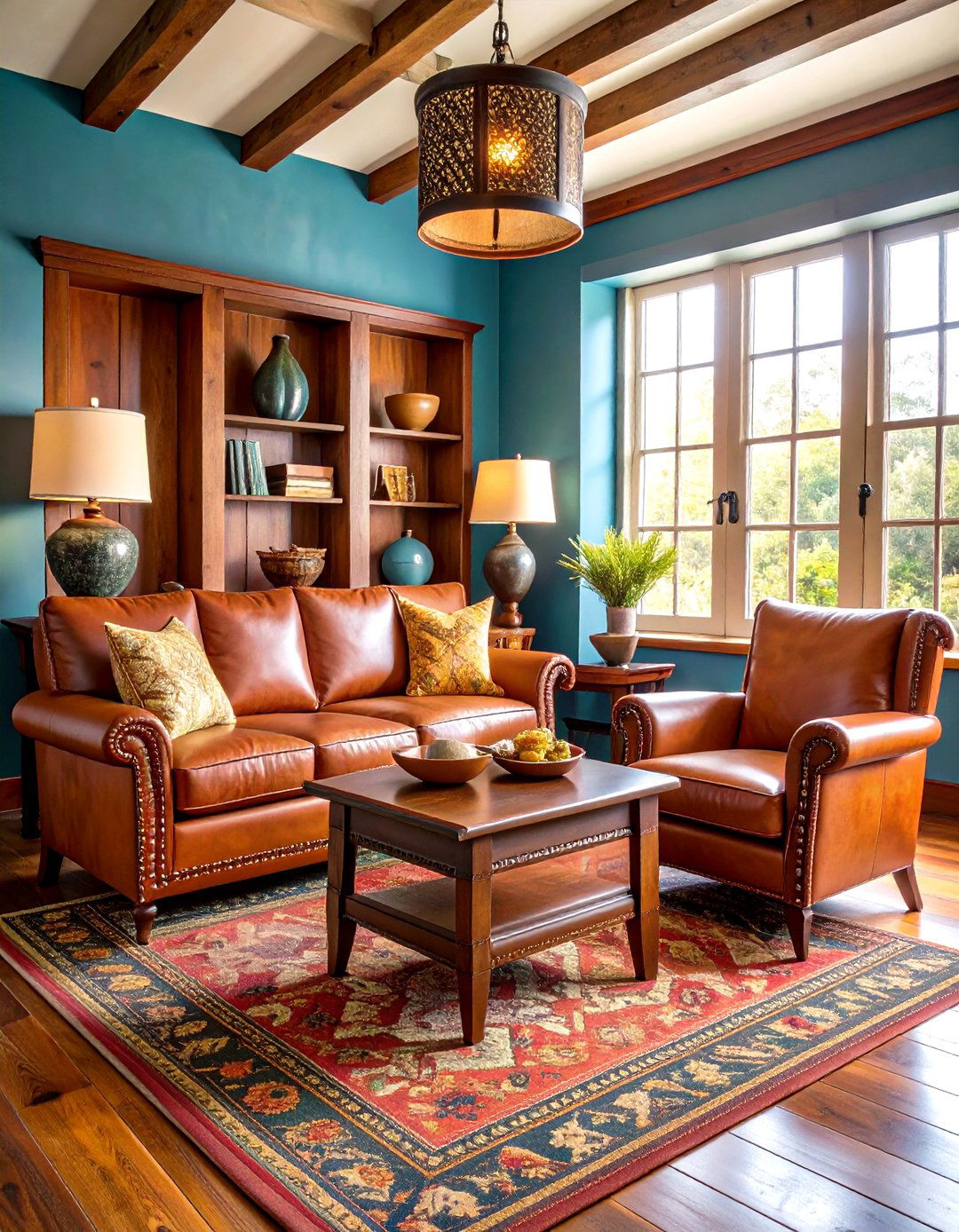
Add seating straight from a colonial hacienda by sourcing sillas equipales—low wooden frames wrapped in thick saddle leather and stitched with rawhide. Vintage dealers on Etsy show how the sling-seat design darkens to a rich caramel patina over decades of use. Pair two chairs with a woven palm stump table for an instant reading nook. Better Homes & Gardens recommends echoing the hide tone elsewhere via leather-bound books or suede cushions to keep the palette cohesive. For durability, rub seats with a mixture of beeswax and citrus oil twice a year so they stay supple under dry climate conditions indoors.
10. Spanish Interior Design Vibrant Mediterranean Color Palette
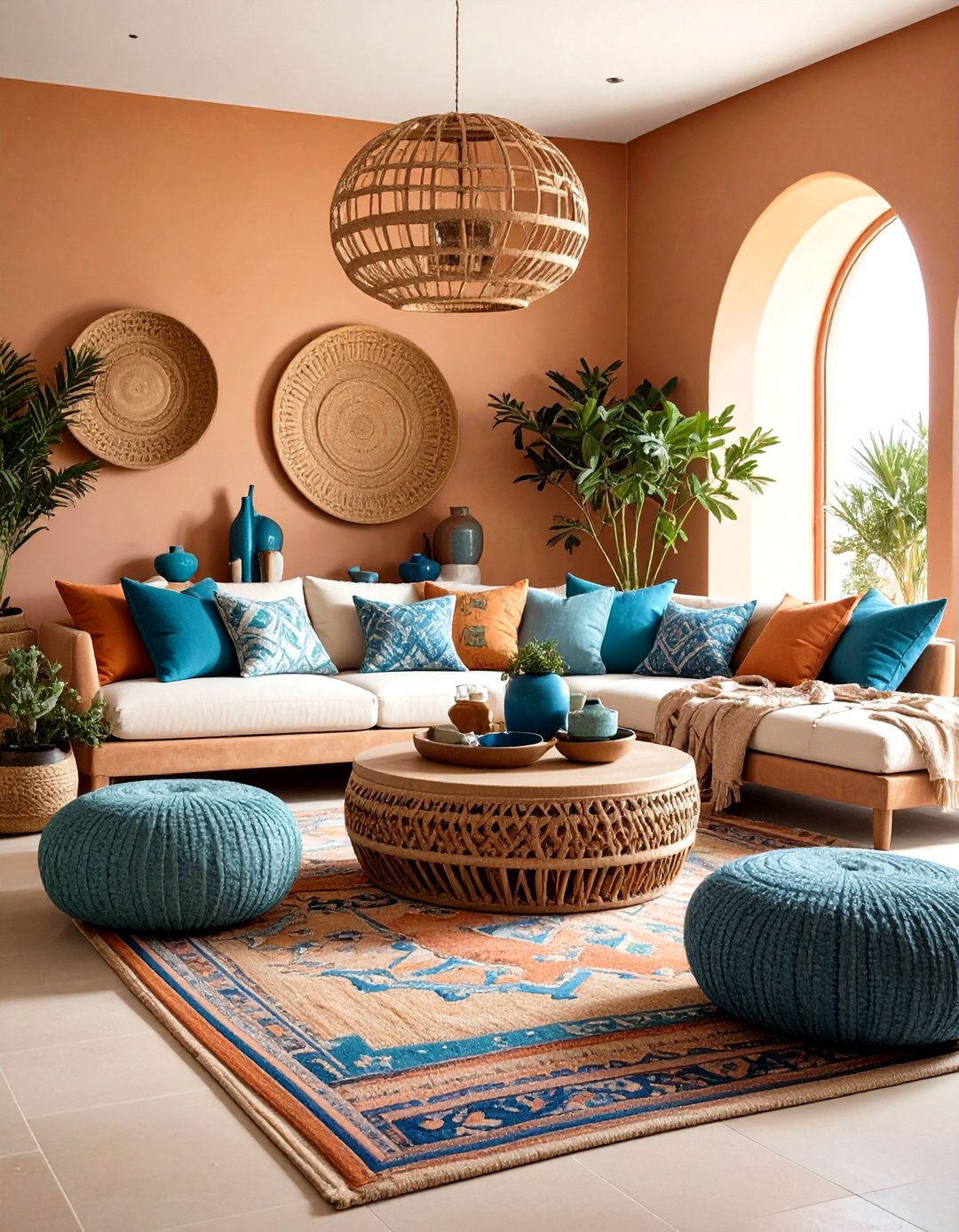
Spanish interiors rarely shy away from color—they simply ground it in nature. Benjamin Moore’s Mediterranean palette suggests sun-baked terra, olive leaf, and deep marine blue as foundational hues that harmonize with clay tiles and wrought iron. Better Homes & Gardens adds that turquoise accents draw from coastal ceramics, refreshing otherwise earthy rooms. Limit yourself to three saturated tones and one neutral so the scheme feels curated, not carnival. Consider painting the backs of open shelves in mustard to highlight white china, or lacquering an arched door in paprika for an unforgettable burst that still respects historical precedent and invites compliments.
11. Spanish Interior Design Hand-Painted Tile Stair Risers
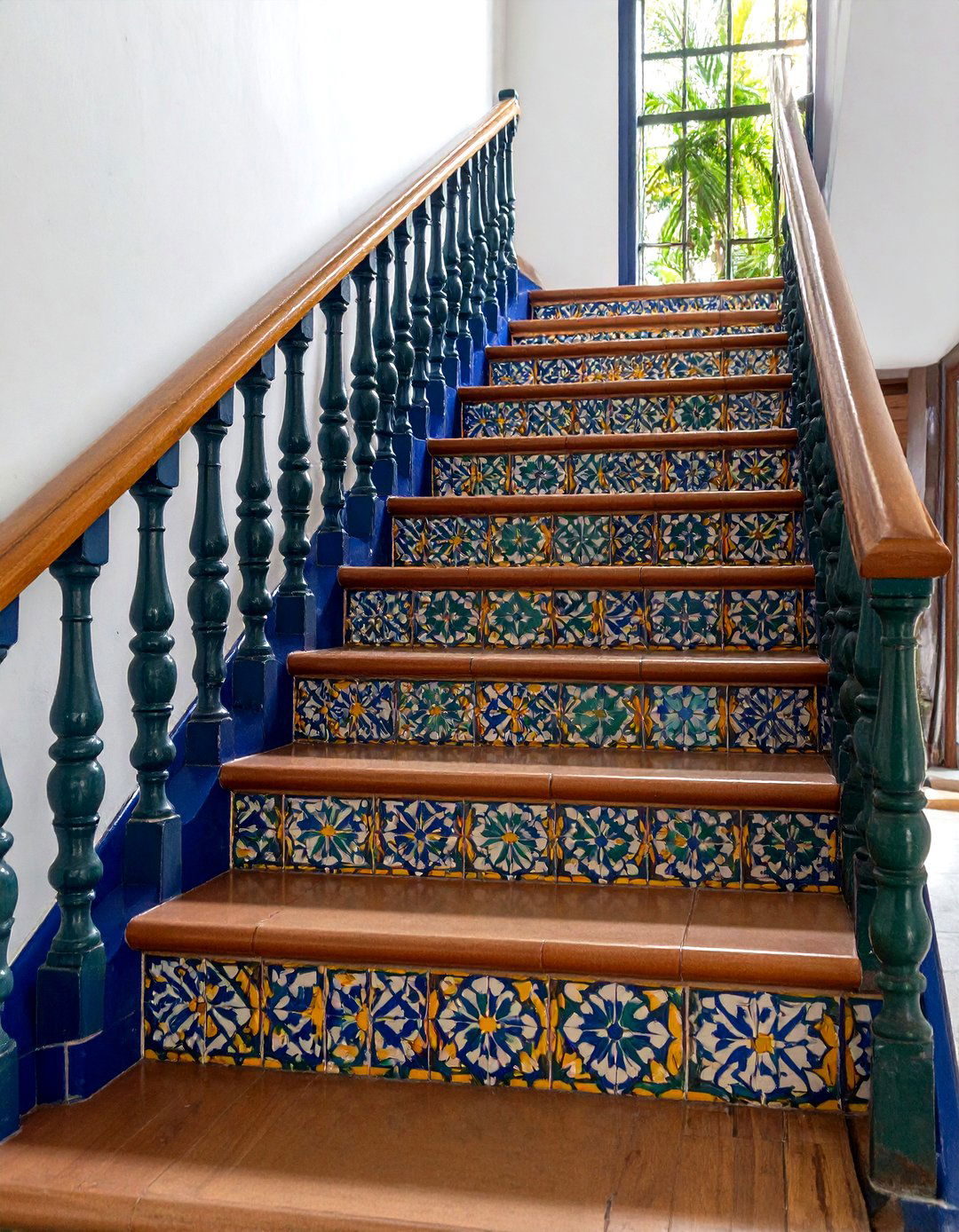
Take an otherwise utilitarian staircase and turn it into a gallery by adorning each riser with a different hand-painted pattern. Houzz showcases homes where Talavera blues alternate with mustard geometrics, creating a rhythmic ascent that doubles as artwork. To install, cut prefabricated 6-by-6 ceramic squares to riser height, apply thinset, and grout in a neutral tone so motifs stay crisp. Color-match the runner to one dominant tile hue for cohesion. Designers interviewed by Decorilla note that patterned risers draw the eye upward, making low ceilings feel taller without structural changes. Finish treads in warm wood so the surface never competes with the lively vertical display.
12. Spanish Interior Design Indoor–Outdoor Courtyard Living

Central courtyards blur boundaries between shelter and sky, a legacy of Moorish villas that still suits modern life. Real Simple explains that hacienda layouts used interior patios to moderate temperature and provide shaded gathering zones scented by citrus trees. Arrange furniture around a trickling stone fountain so sound masks city noise, then string wrought-iron lanterns overhead for evening ambience. The Spruce observes that terracotta pots overflowing with bougainvillea or rosemary echo exterior tiles and enliven white walls. When space is tight, even a small atrium with a skylight and operable French doors can deliver the same restorative, sun-dappled experience indoors.
13. Spanish Interior Design Whitewashed Plaster Fireplaces
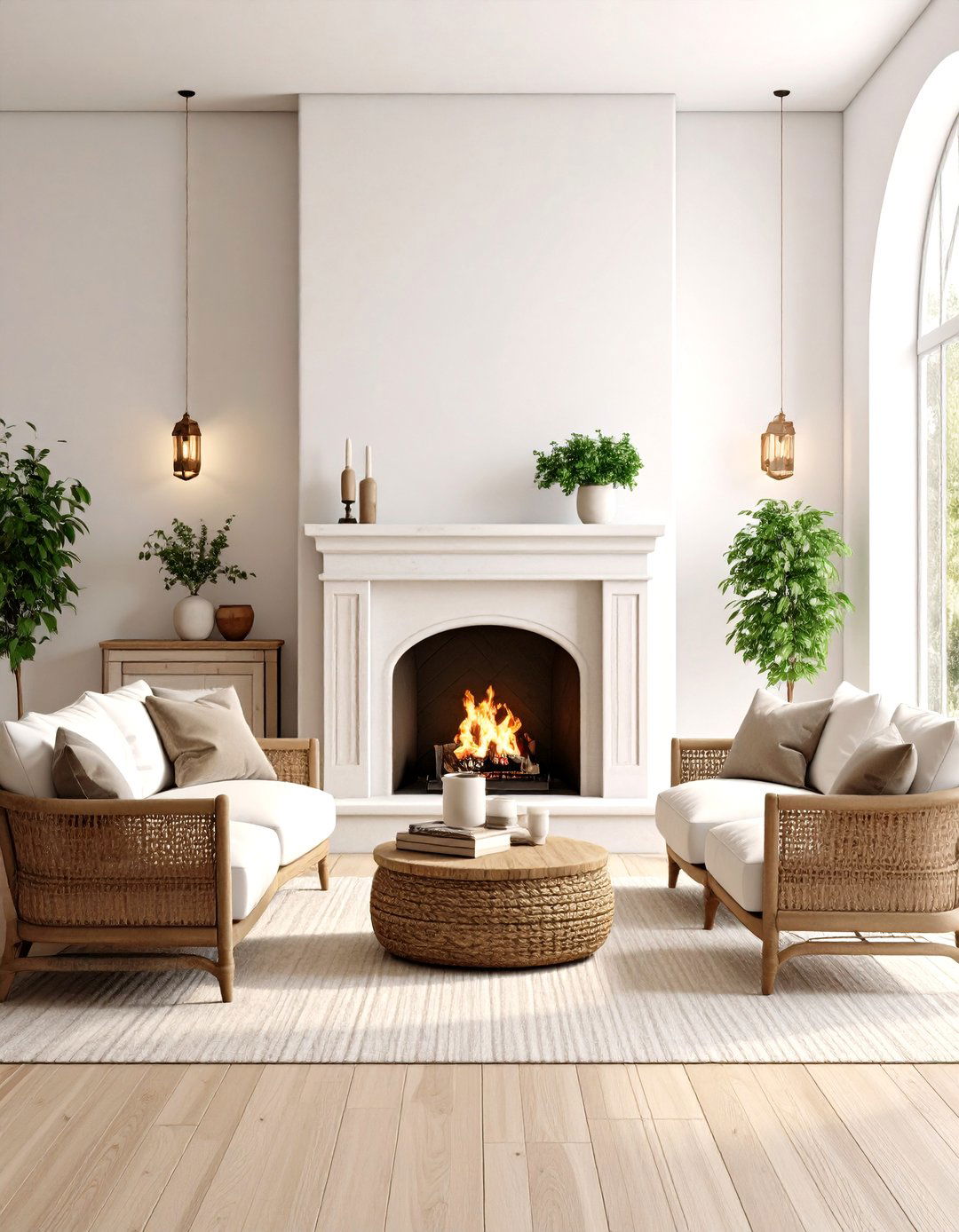
A whitewashed kiva or corner fireplace anchors a living room while maximizing floor area. The Spruce points out that smooth plaster absorbs heat slowly and releases it evenly, a welcome feature on cool Mediterranean nights. Coat the surround in breathable limewash so hints of brushstroke stay visible; the subtle texture prevents the mass from reading as a blank monolith. Architectural Digest photo spreads often contrast the chalky hearth with reclaimed-wood mantels and hammered-copper screens. For extra depth, carve a sinuous banco seat into the base—perfect for storing pillows by day and warming toes by firelight after sunset in the evenings.
14. Spanish Interior Design Patterned Textiles & Embroidered Throws
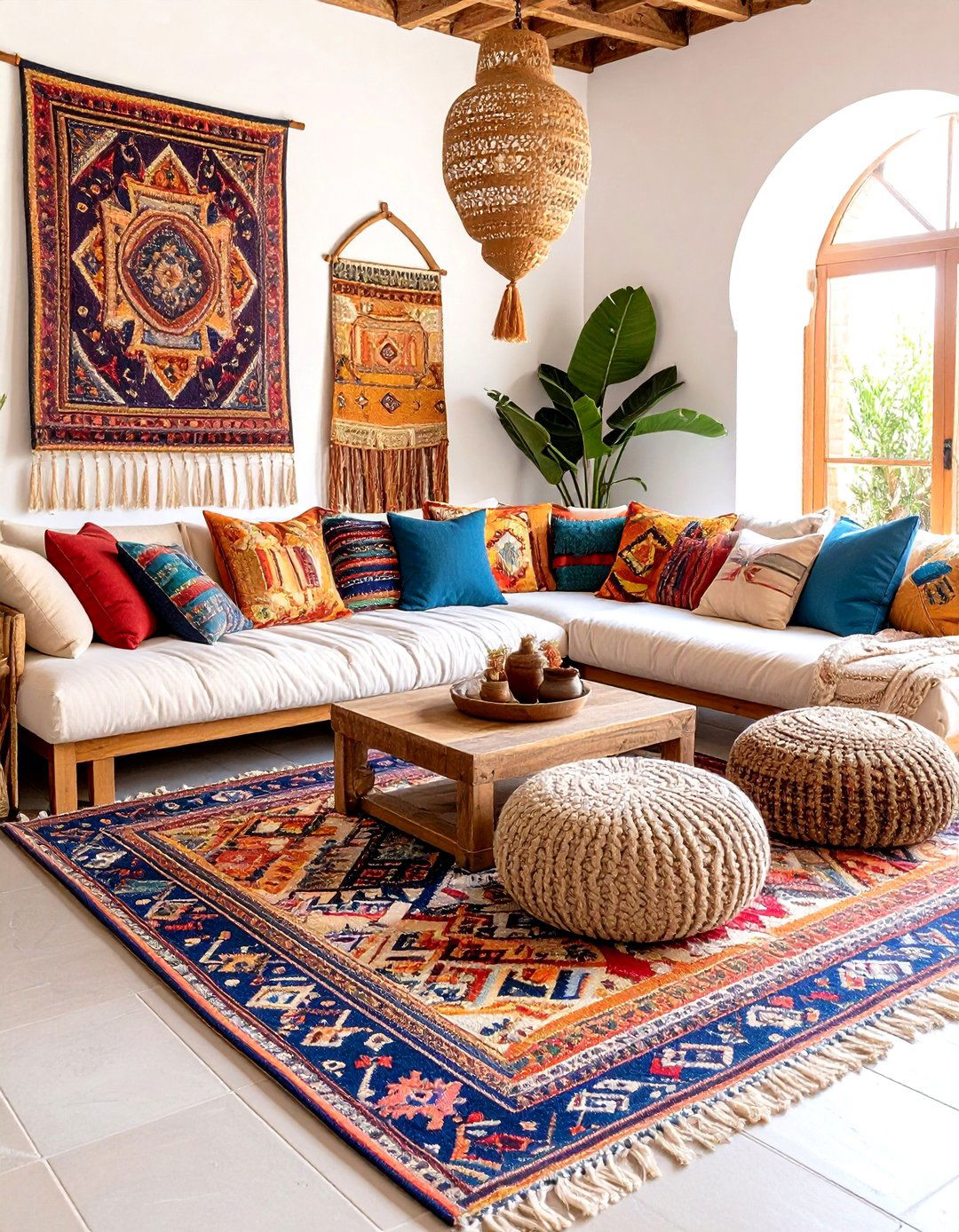
Textiles lend the color play that gives Spanish rooms their festive soul. Elle Decor showcases suzani-backed sofas and cochineal-dyed pillows layered over plain linen slips for easy seasonal swaps. Choose flamenco-inspired stripes, Andalusian ikats, or Catalan ticking; keep scales varied so patterns dance rather than clash. Architectural Digest editors suggest grounding vibrant fabrics with a jute rug and ebony coffee table, letting embroidery remain the star. When draping a throw on a leather equipale, pull colors from Talavera pottery to harmonize zones. Finish with braided-wool tassels that brush terracotta floors and invite barefoot lounging on warm Andalusian afternoons or evenings.
15. Spanish Interior Design Forged-Iron Lighting Fixtures
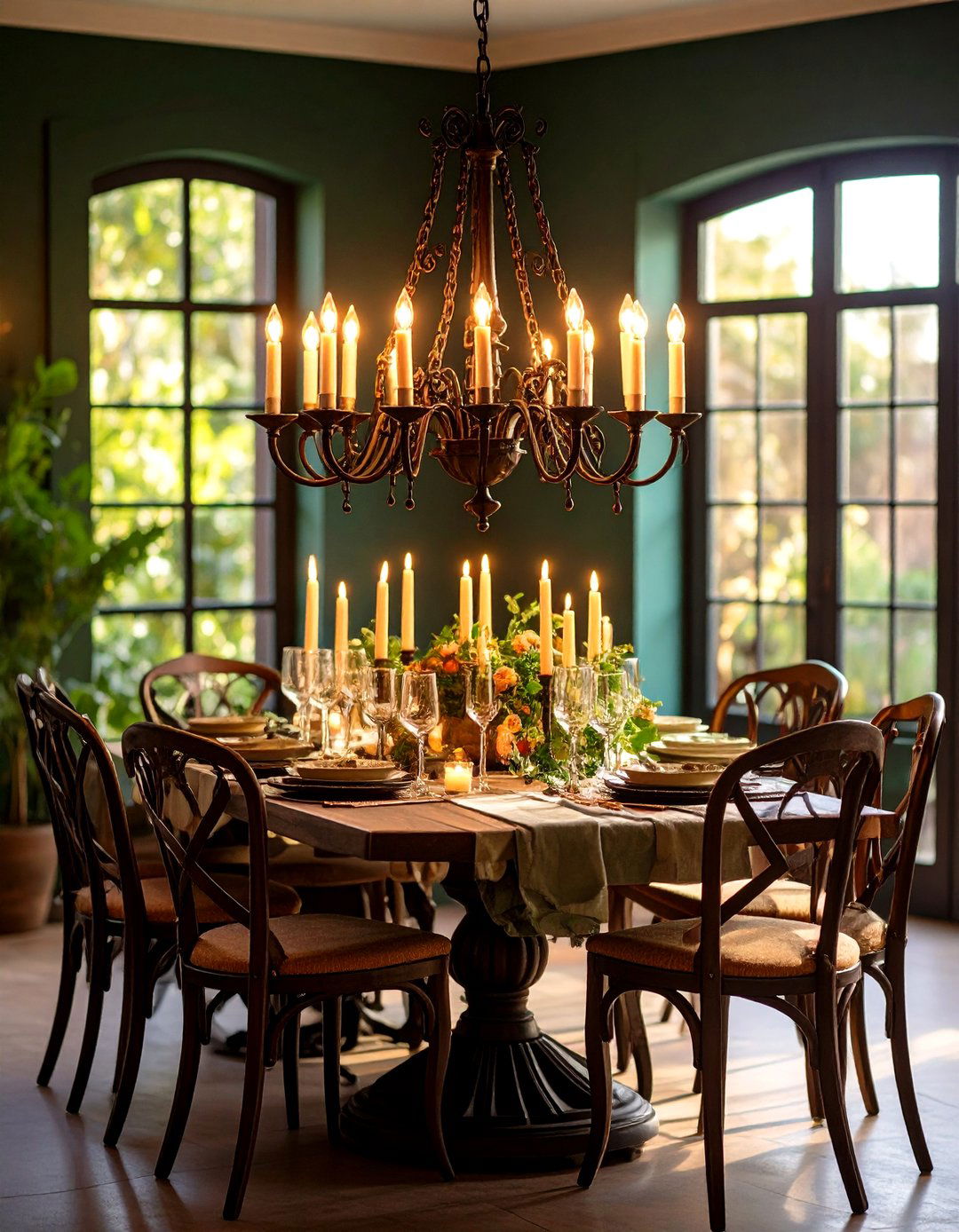
Lighting is jewelry for the Spanish interior, and forged iron pieces sparkle with old-world authenticity. A Houzz feature on Old-World lighting reveals chandeliers where twisted scroll arms cradle wax-look candles, casting romantic shadows across stucco walls. Woodgrain notes that dark iron balances terracotta floors by adding a cool counterpoint; use warm Edison bulbs so the overall palette remains inviting. For smaller rooms, pick a single three-light lantern and echo its shape in cabinet hardware; in grand halls, cluster pendants of varying drop lengths to mimic cathedral naves. Always install dimmers to transition seamlessly from bright siesta tasks to sultry evening gatherings.
16. Spanish Interior Design Spanish Revival Mosaic Backsplashes

A mosaic backsplash is the kitchen’s jewelry box, and Spanish Revival patterns—think quatrefoil stars and stylized florals—deliver dazzle in bite-size form. Woodgrain’s style guide recommends combining terracotta field tiles with hand-cut accent inserts for depth and movement. Decorilla designers caution that overwhelming color can date quickly; instead they suggest a restrained palette of two brights plus one neutral, allowing grout lines to articulate shapes crisply. Finish edges with bullnose trim or a slender wrought-iron rail for crossover continuity. Extend a single motif onto the range-hood skirt so the backsplash reads like an intentional mural rather than a random patch of pattern.
17. Spanish Interior Design Hacienda-Style Central Fountain
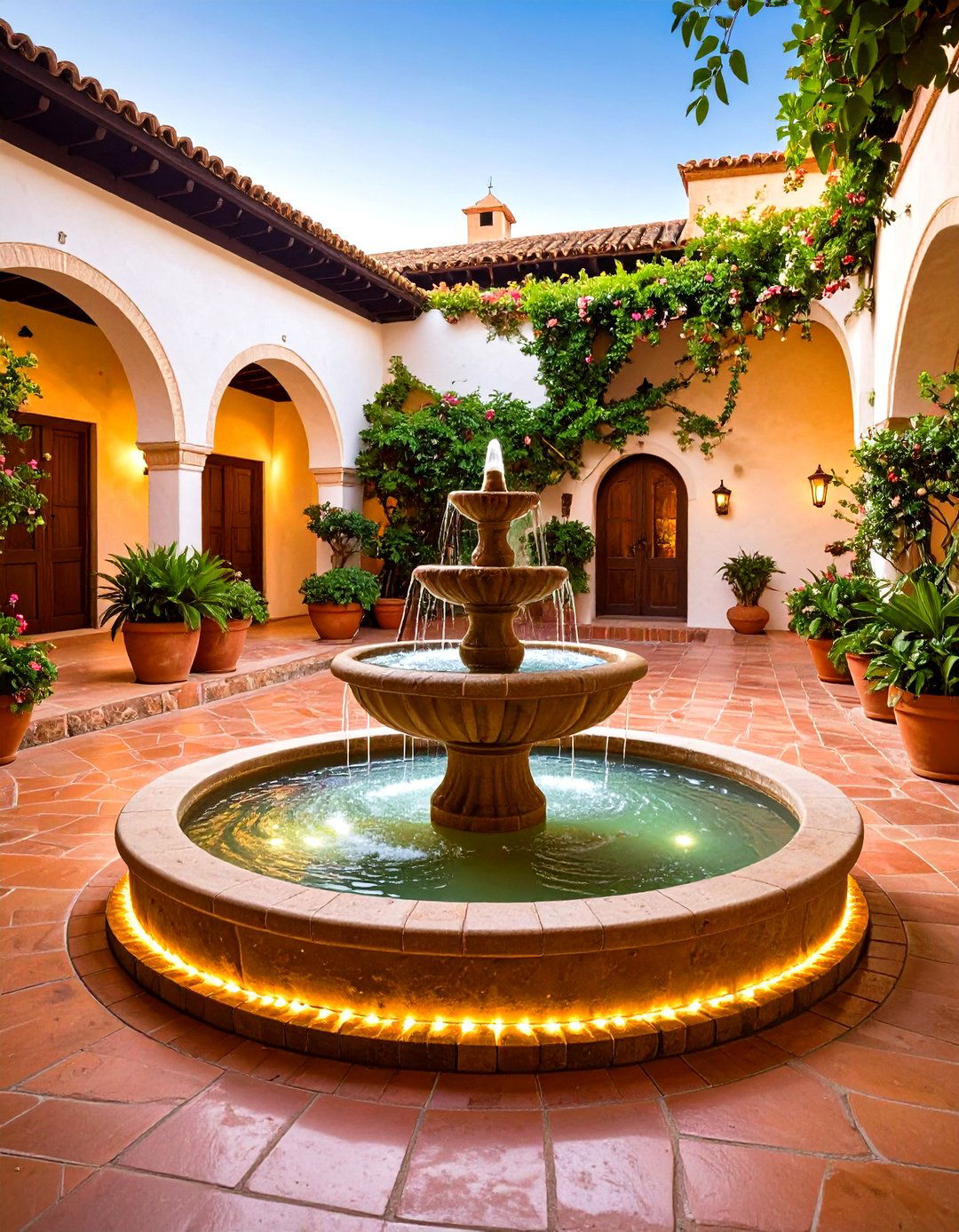
A gently burbling fountain placed at the heart of a room or courtyard anchors space both acoustically and spiritually. Real Simple highlights their historical role in hacienda estates, where water symbolized life and provided cooling evaporation. Choose a low basin carved from cantera stone and set it flush with terracotta tiles for easy foot traffic. The Spruce recommends planting potted jasmine or dwarf citrus nearby so scent mingles with the sound. Incorporate low-voltage underwater LEDs to create nighttime sparkle, and use a recirculating pump rated for continuous indoor operation to keep maintenance effortless even during long, arid summer months there.
18. Spanish Interior Design Modern Spanish Minimalist Fusion
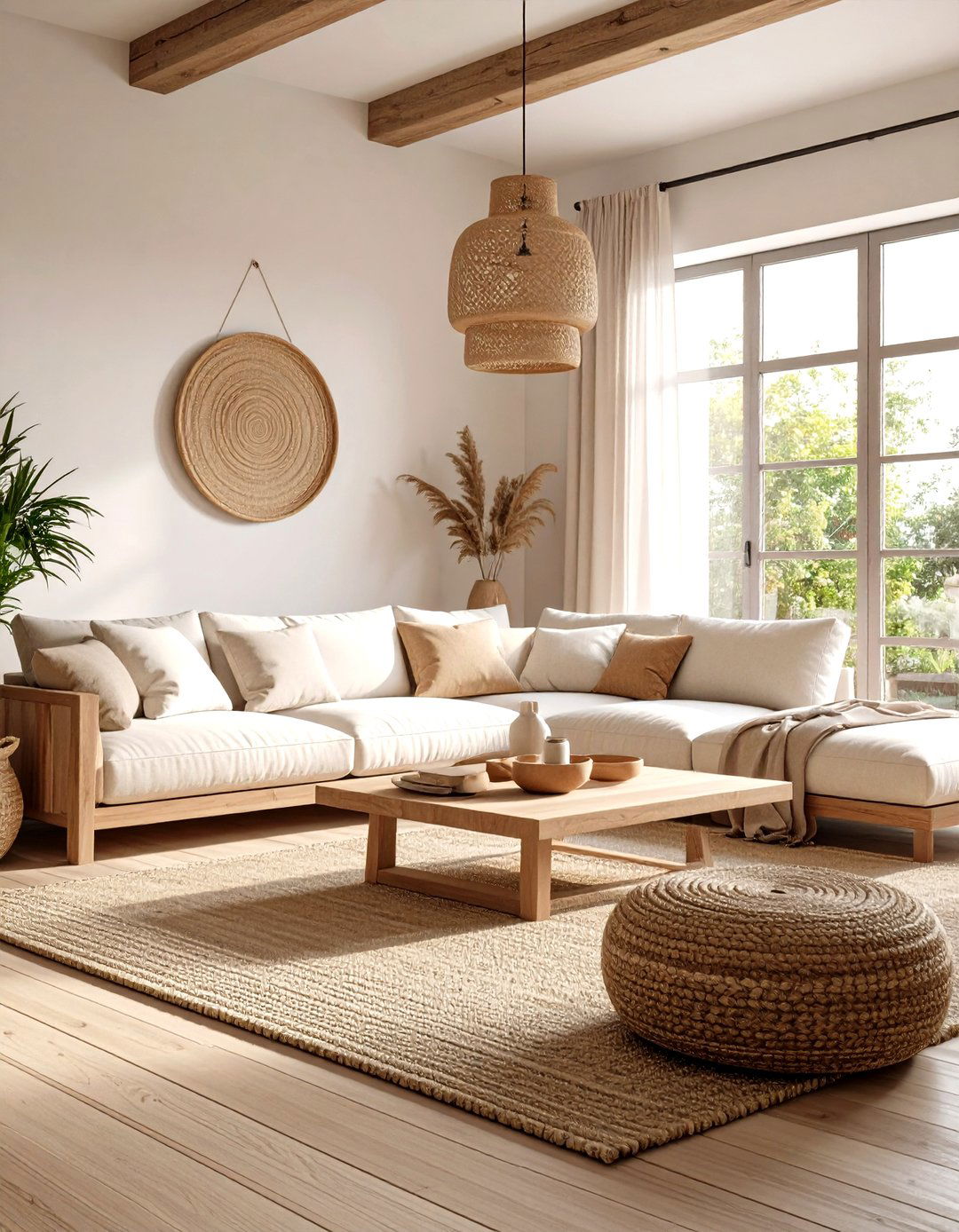
Minimalism and Spanish tradition need not clash; the key lies in material honesty. Decorilla’s modern Spanish guide advises retaining classic elements—beams, terracotta, arches—while streamlining furniture silhouettes and trimming ornamentation. Swap heavy dark woods for pale oak slabs, then float a single low linen sofa on a sisal rug so architectural bones shine. Architectural Digest profiles Los Feliz revamps where white walls, steel-rimmed windows, and vintage Spanish tile coexist gracefully. Keep the palette to clay, chalk, and charcoal, injecting color only through artisanal pottery to maintain serenity yet honor heritage, and ensure airy volumes feel calm, cool, and timeless throughout spaces.
19. Spanish Interior Design Antique Spanish Mirrors
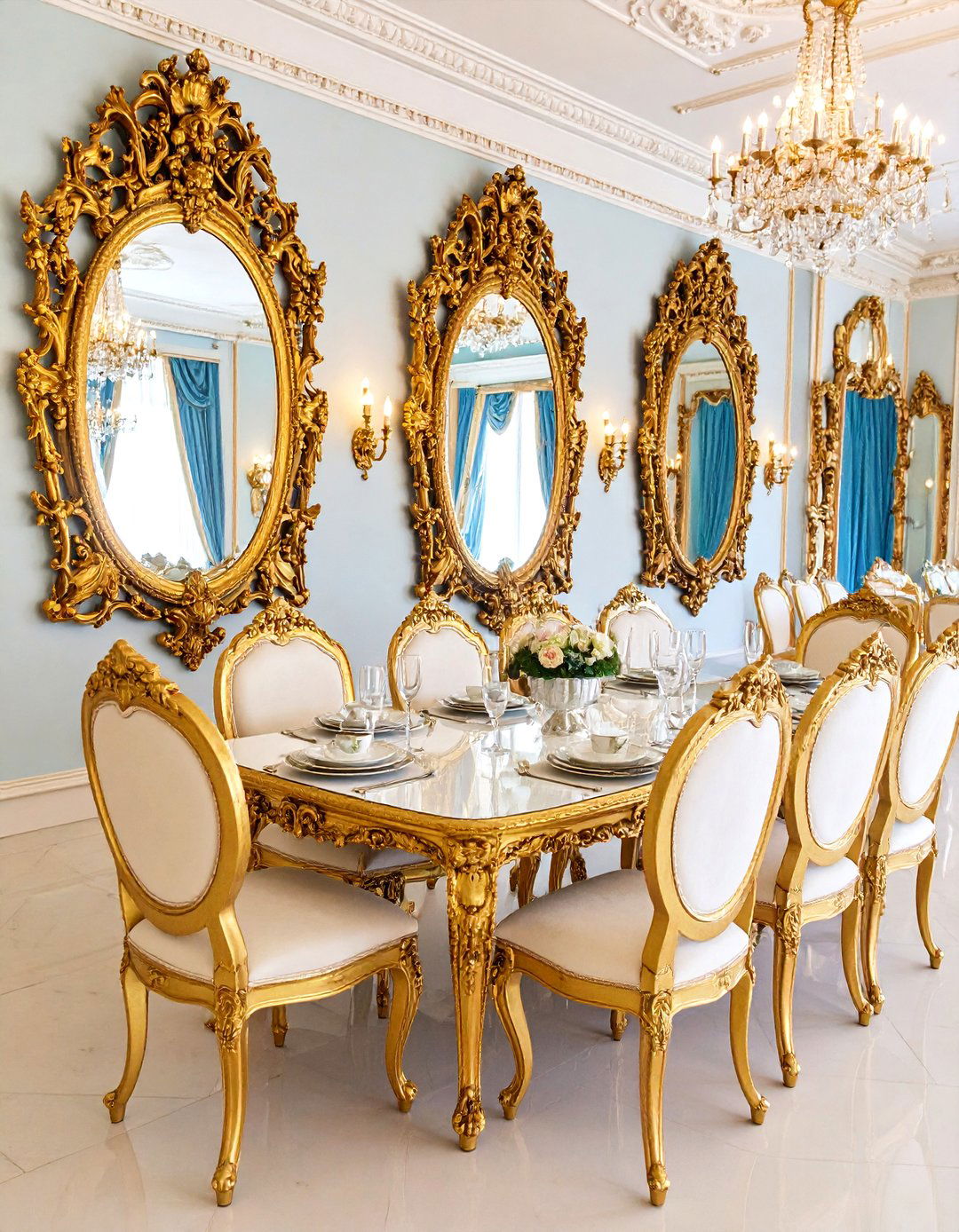
Antique Spanish mirrors—with chunky gilt frames or intricate marquetry—bounce sunlight deep into thick-walled rooms. Veranda’s Dallas Spanish Colonial tour shows an 18th-century baroque mirror amplifying candlelight in a formal dining space. Place a tall pier mirror opposite an arched doorway to double the vista and draw guests forward. Architectural Digest notes that distressed mercury glass mimics centuries of wear and pairs well with rough plaster. Hang mirrors slightly lower than modern standards so their reflective field captures tiled floors and carved doors, reinforcing vertical connections. Use leather straps or wrought-iron brackets instead of modern clips to maintain period authenticity beautifully.
20. Spanish Interior Design Barrel-Vaulted Brick Ceilings
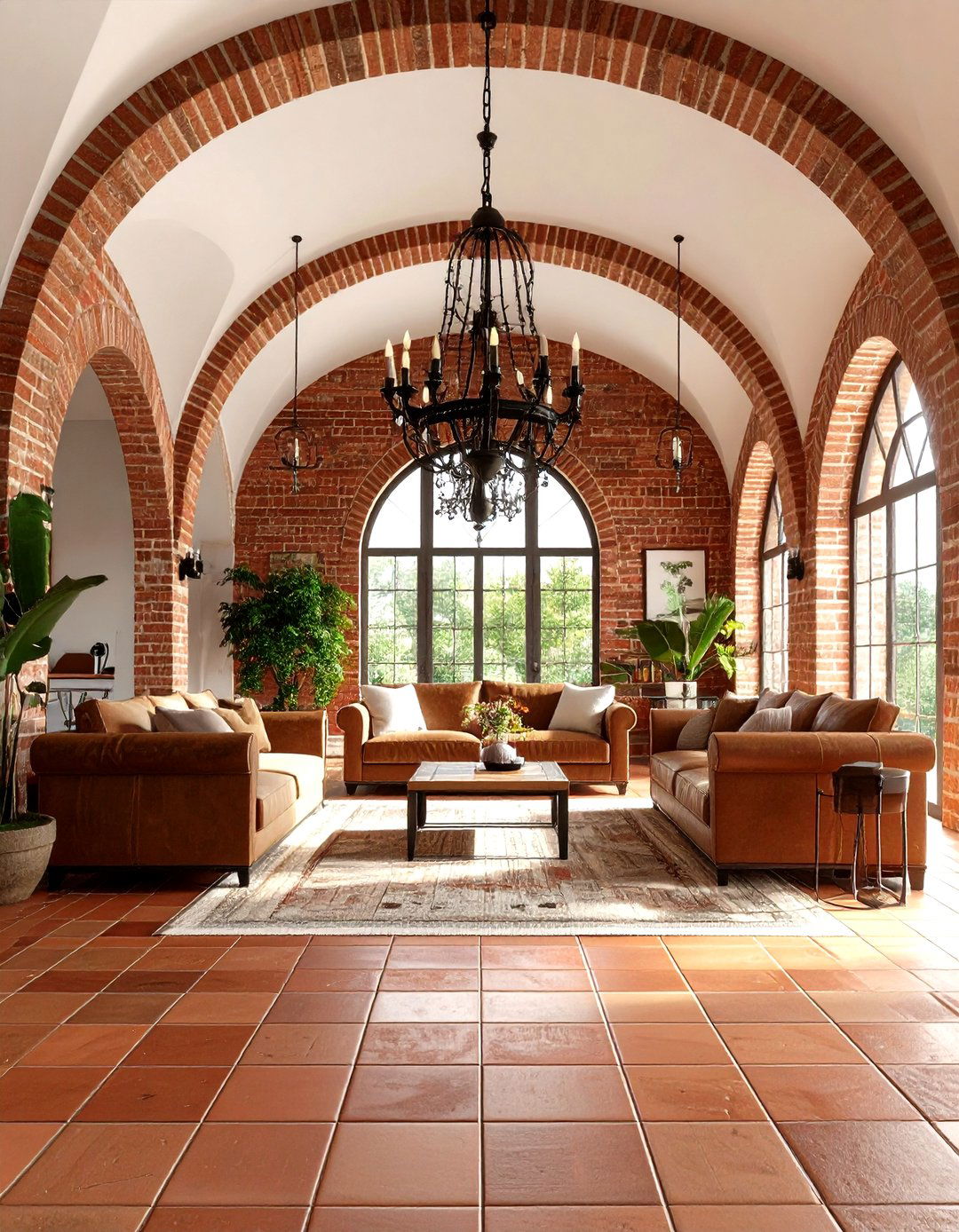
A barrel-vaulted ceiling lined in reddish brick delivers instant hacienda gravitas. Dwell magazine documents multiple 1920s Los Angeles revivals where masons laid thin pavers over lightweight forms, then white-washed mortar joints for subtle diffusion of light. The gentle curve helps hot air rise, naturally cooling living areas beneath. Pair the vault with wrought-iron chandeliers hung from forged straps that follow the arc, avoiding pendants that would interrupt the rhythm. If structural vaulting is unrealistic, mimic the look with brick veneer panels applied to a framed arch, a trick highlighted by Decorilla’s renovation team. Finish side walls in smooth plaster so the textured canopy remains the undeniable star.
Conclusion:
All things considered, these twenty Spanish interior design ideas demonstrate how craft, color, and architectural form unite to create environments that feel both historic and freshly alive. Mix no more than a handful of elements at a time—stucco with iron, terracotta with patterned tile—to avoid pastiche and let each texture sing. Whether you embrace a single Talavera splash or undertake a full courtyard remodel, Spanish style rewards authenticity, natural materials, and joyful ornament. Use the concepts above as a roadmap, then layer personal treasures to craft a home as welcoming as a sunlit Andalusian plaza.


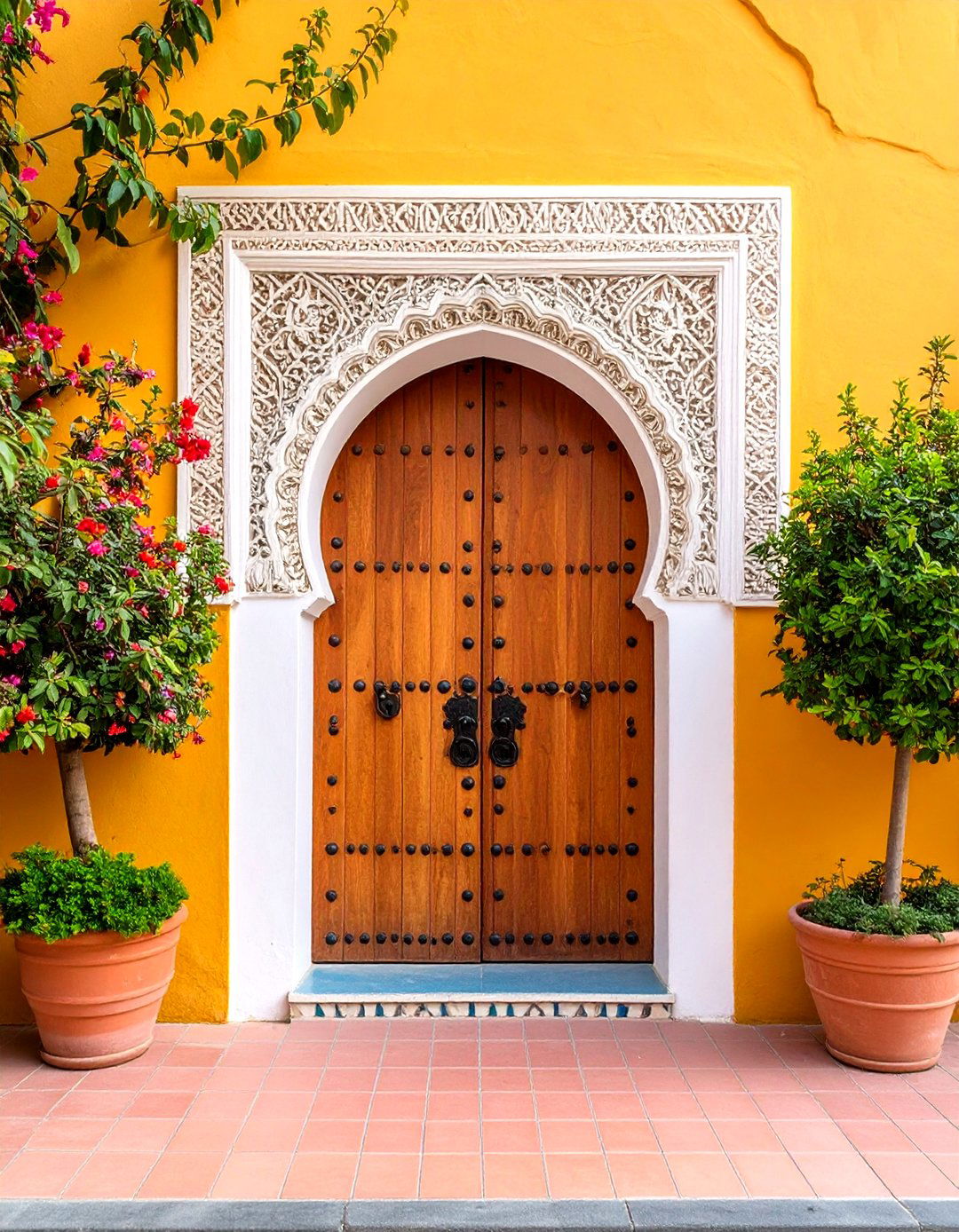
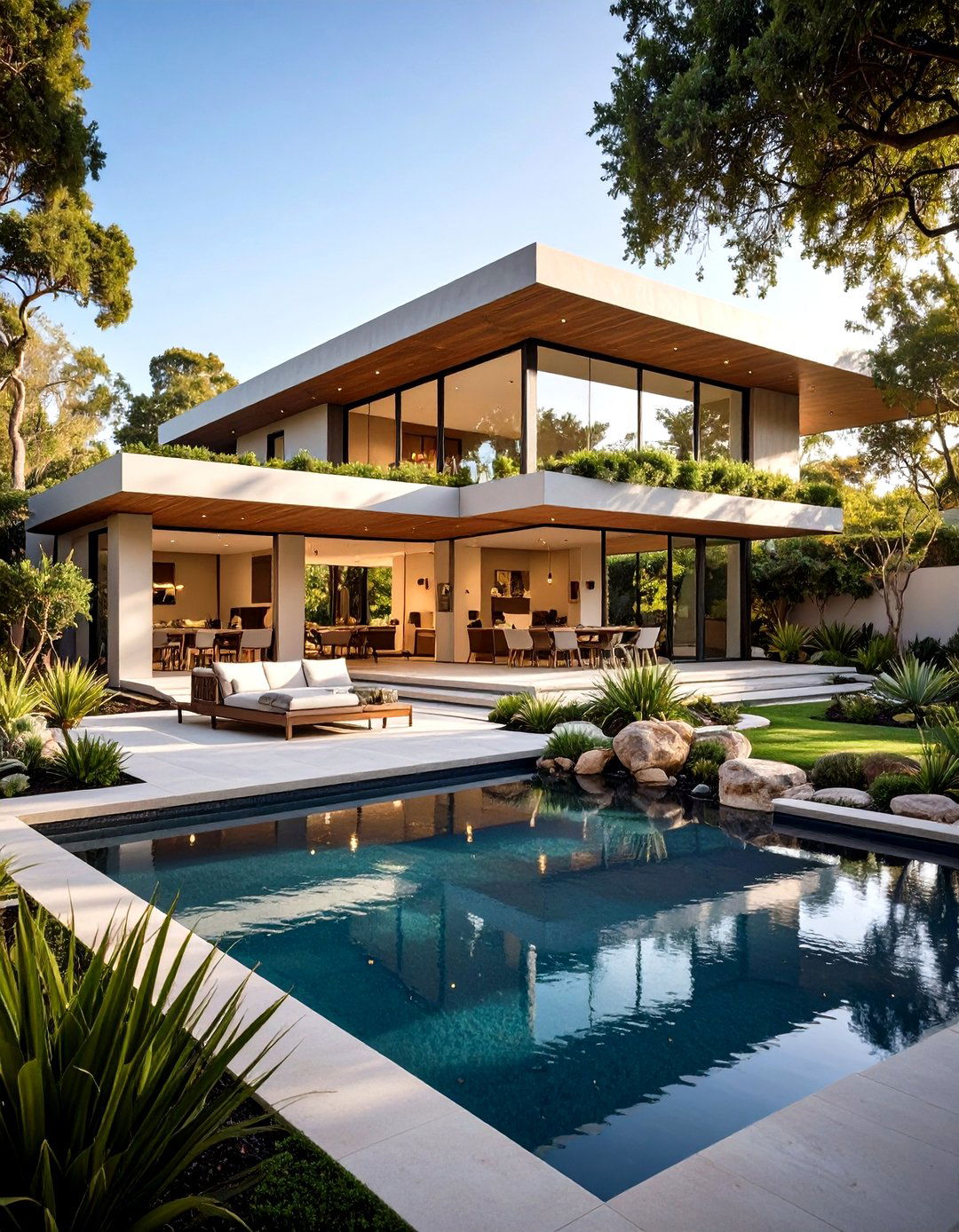

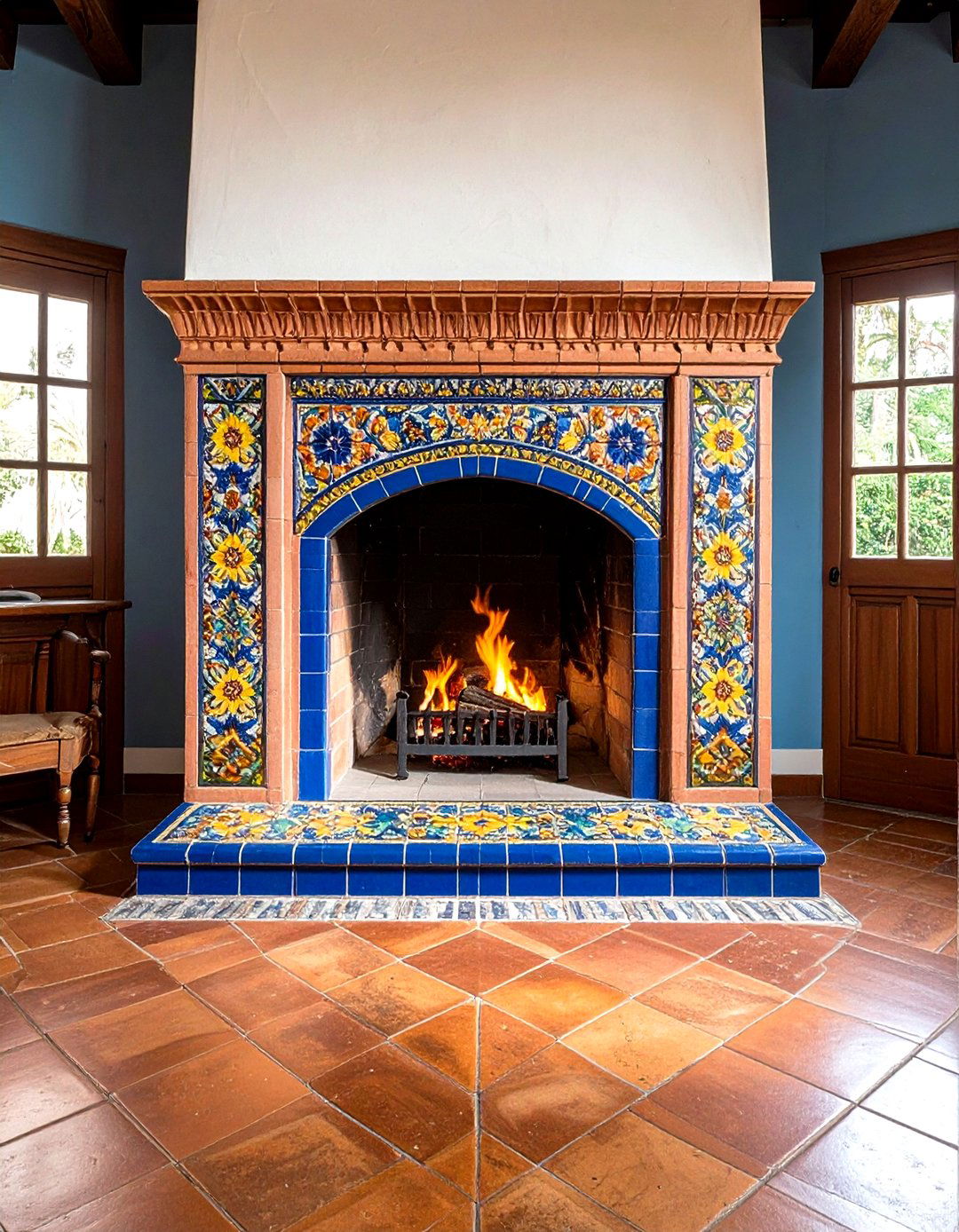
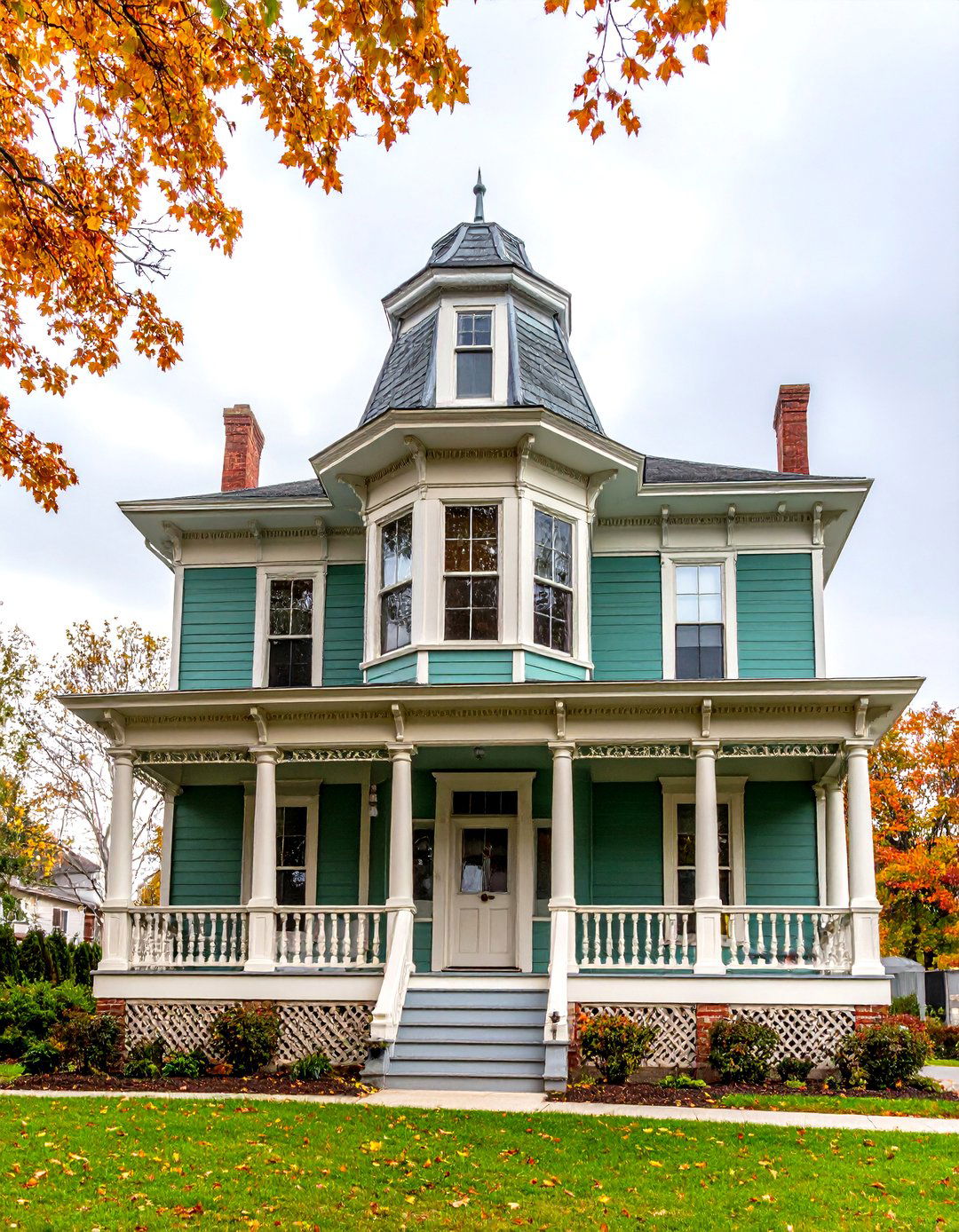
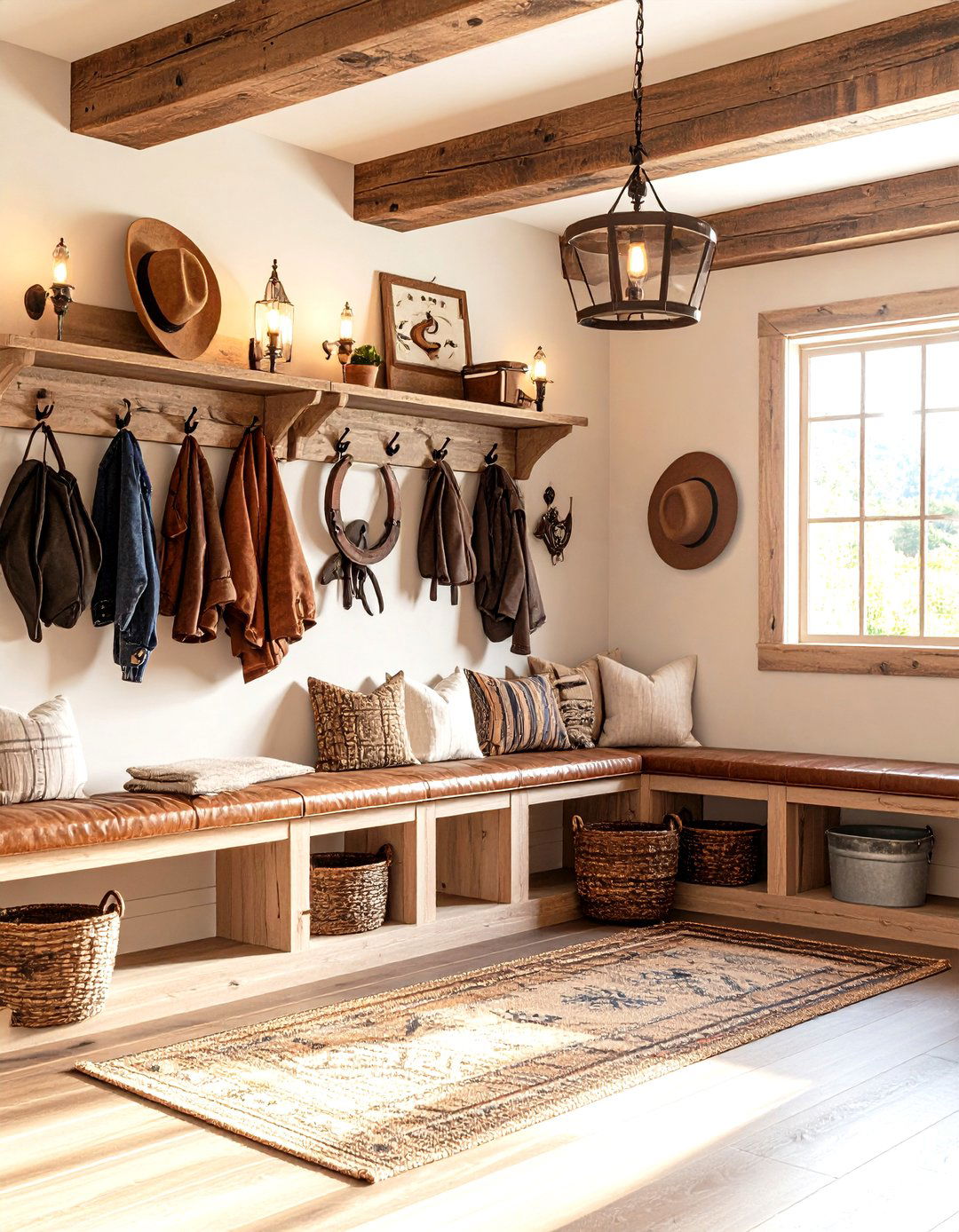

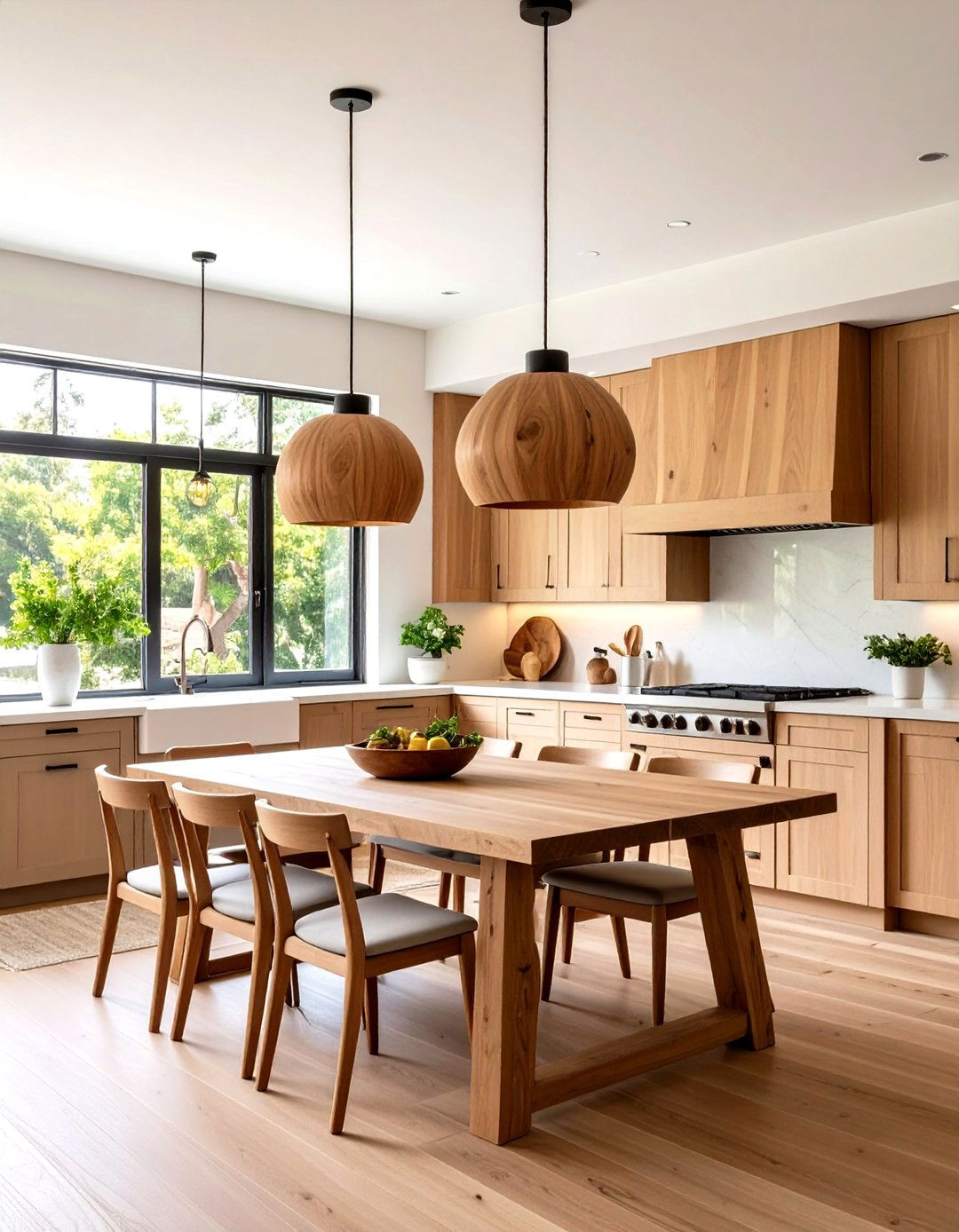
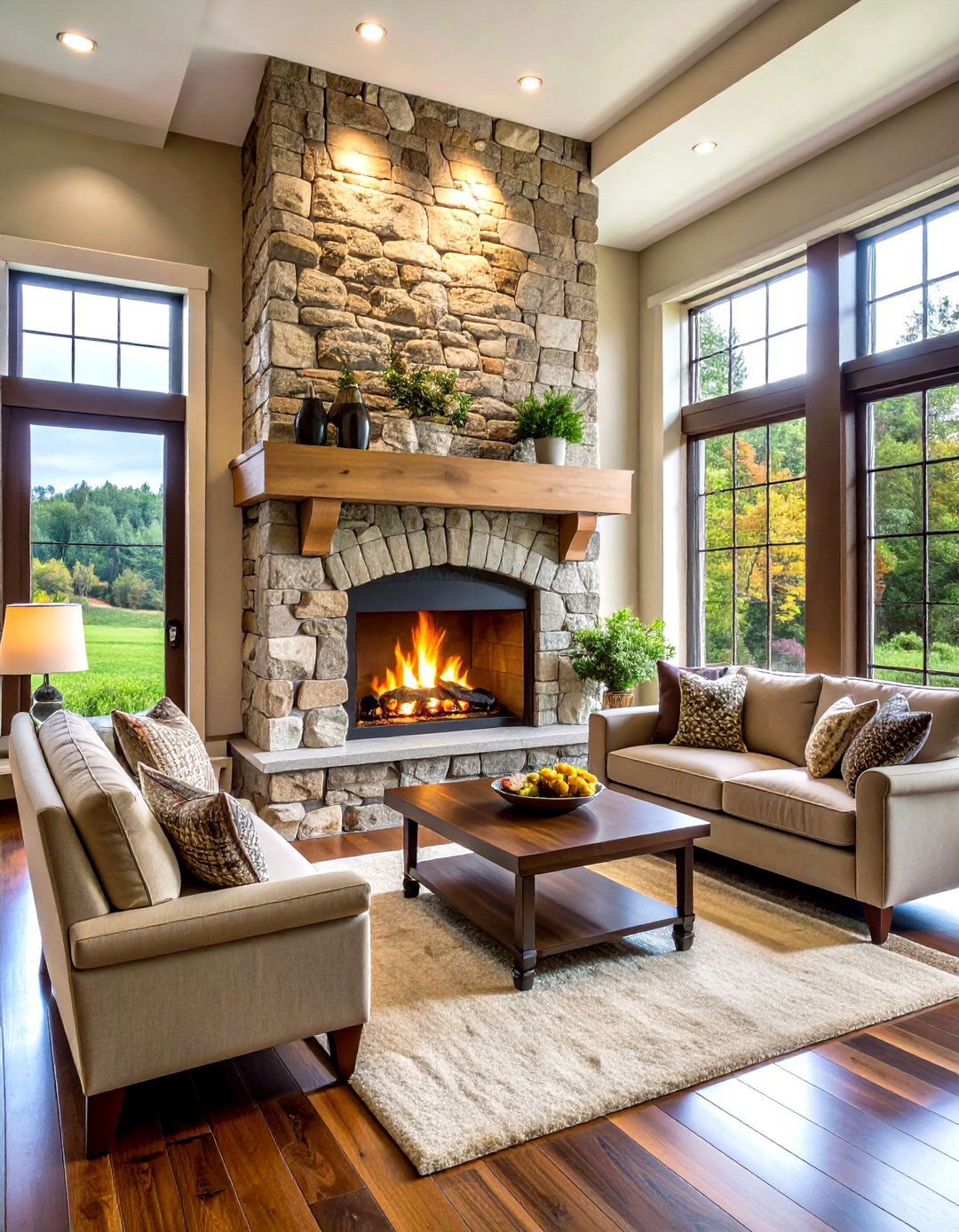
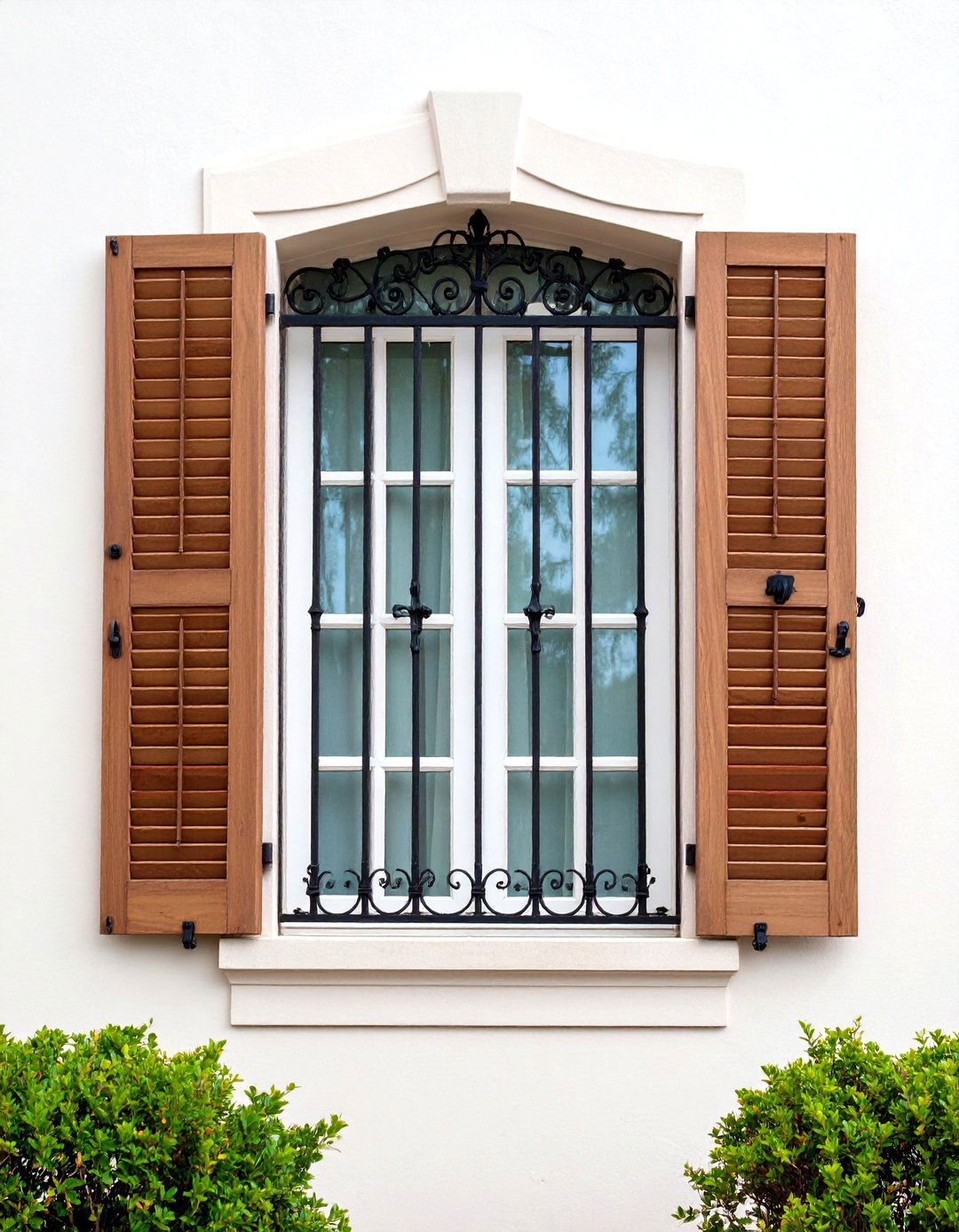



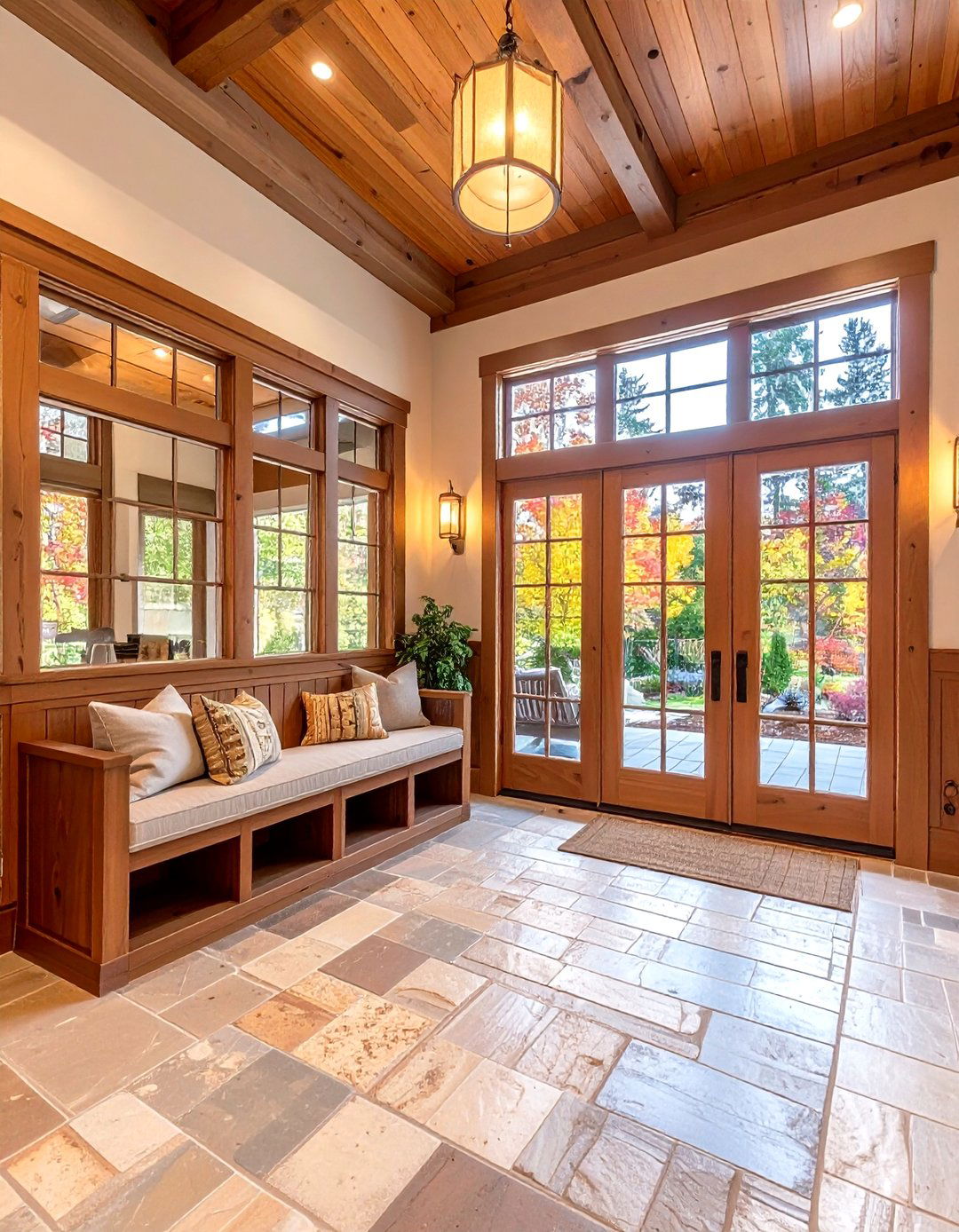

Leave a Reply